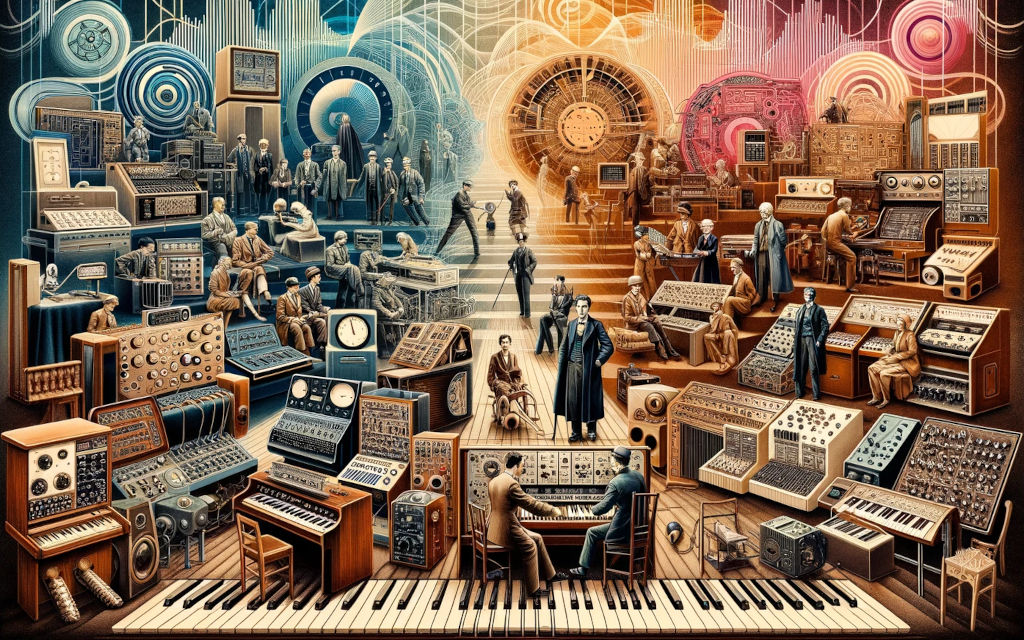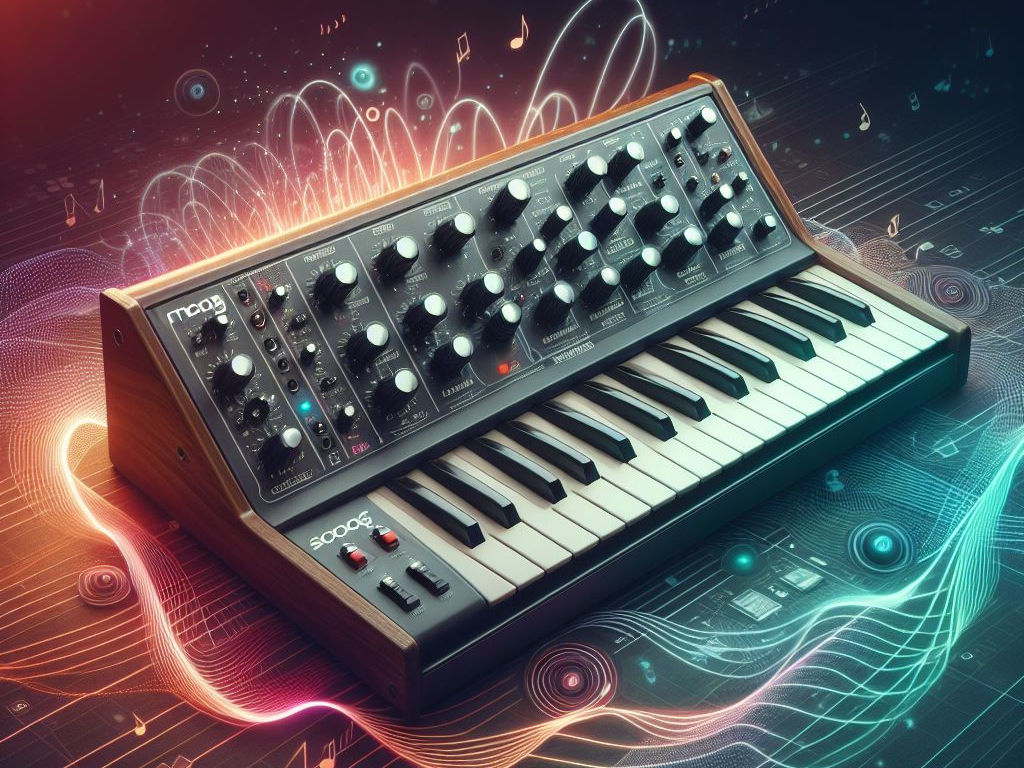
The Roots of Electronic Music
To truly understand electronic music, we must embark on a voyage through its rich and diverse history, where innovation and experimentation have been its guiding stars. This journey begins in the early 20th century, as groundbreaking inventors and musicians laid the foundation for the electronic soundscape we know today.
The Birth of Electronic Sound
The 1920s stands as a remarkable era in the annals of music history, particularly with the advent of electronic sound. It was during this decade that a pioneering Russian physicist named Leon Theremin introduced a groundbreaking invention that would forever change the sonic landscape of music—the Theremin. This otherworldly instrument, born from the fertile grounds of scientific curiosity and artistic imagination, relied on the subtle and enigmatic gestures of the players hands to manipulate electromagnetic fields, conjuring hauntingly beautiful and ethereal sounds that captivated audiences and laid the foundation for electronic music as we know it today.
The Theremin, an instrument as mysterious as the sounds it produced, embodied the fusion of science and art, offering a glimpse into the limitless possibilities that technology could unlock in the realm of music. Unlike traditional instruments that required physical contact, the Theremin operated through the manipulation of electromagnetic waves. The players hands, delicately hovering near two antennas, disrupted these fields, altering the pitch and volume of the sound produced. The result was a mesmerizing and eerie sonic experience that seemed to emanate from the very ether itself.
One cannot overstate the impact of the Theremin on the musical world. Its debut at the time was nothing short of revolutionary, introducing audiences to a new, almost alien soundscape that stretched the boundaries of what music could be. The Theremins unique timbre lent itself to a wide range of emotional expression, from haunting and mournful to ethereal and dreamlike, making it a versatile tool for composers and performers alike.
In the years following its introduction, the Theremin found its way into various musical contexts, from classical compositions to experimental electronic works. Clara Rockmore, a virtuoso Thereminist, became one of its most celebrated interpreters, showcasing the instruments potential for virtuosic expression and emotive storytelling.
As the decades rolled on, the influence of the Theremin on electronic music continued to grow. The development of synthesizers and electronic instruments in the mid-20th century owed a debt to Leon Theremins pioneering work. These instruments, in turn, paved the way for the electronic music explosion of the late 20th century and beyond.
Today, the Theremin remains an iconic symbol of electronic musics early origins and a testament to the power of human ingenuity and creativity. While electronic music has evolved in countless ways since the 1920s, the eerie and enchanting sounds of the Theremin still resonate with a sense of wonder and fascination. Its legacy lives on in the experimental works of contemporary electronic musicians who continue to push the boundaries of sound and technology.
In the grand tapestry of musical history, the birth of electronic sound through the invention of the Theremin stands as a testament to the timeless human desire to explore new sonic horizons. It serves as a reminder that innovation knows no bounds and that the marriage of science and art can yield creations that transcend the limitations of their time, forever altering the course of music and inspiring generations of musicians to come. The Theremins haunting and ethereal melodies will forever echo through the corridors of musical innovation, a testament to the indomitable spirit of creativity and discovery that drives the evolution of music itself.

Pioneering Synthesis
The 1950s was a transformative decade for music, marking a pivotal moment in the history of electronic sound with the introduction of the Moog Synthesizer by electronic music pioneer Robert Moog. This remarkable invention, the worlds first voltage-controlled synthesizer, opened the door to a new realm of musical possibilities, enabling musicians to manipulate and craft entirely new sounds through the ingenious application of oscillators, filters, and envelopes.
Robert Moog, a visionary engineer and music enthusiast, had a deep fascination with electronic sound and the potential for technology to shape the musical landscape. His pioneering work in the realm of electronic music synthesis laid the foundation for a revolution that would forever alter the way music was composed, produced, and heard.
The Moog Synthesizer, unveiled in the 1960s, represented a quantum leap in musical innovation. At its core were voltage-controlled oscillators (VCOs) that generated waveforms of various shapes, providing a palette of fundamental sounds to work with. Musicians could adjust the pitch, timbre, and modulation of these oscillators with precision, giving birth to a universe of sonic textures previously unattainable with traditional instruments.
But the true magic of the Moog Synthesizer lay in its filters and envelopes. Voltage-controlled filters (VCFs) allowed for the sculpting of harmonics and tonal character, shaping the sounds brightness or warmth. Envelopes, both amplitude (ADSR) and filter (AD), introduced dynamic control, enabling sounds to evolve over time, from sharp plucks to sustained pads.
The impact of the Moog Synthesizer on music cannot be overstated. It revolutionized not only the way musicians created sounds but also the genres and sonic landscapes they explored. Electronic music, which had previously been a niche, experimental field, found its voice and began to permeate popular music, film scores, and avant-garde compositions.
Wendy Carloss 1968 album "Switched-On Bach" was a pioneering example of the Moog Synthesizers capabilities, reimagining classical compositions with electronic sounds. In rock and pop music, artists like The Beatles, Pink Floyd, and Stevie Wonder incorporated Moog Synthesizers into their songs, introducing the instrument to a broader audience.
As electronic music continued to evolve in the following decades, the Moog Synthesizer remained a cherished and sought-after instrument among musicians and producers. Its distinctive analog warmth and expressive capabilities made it a staple in both classic and contemporary electronic music.
The legacy of Robert Moogs pioneering synthesis work lives on in todays music production. While technology has advanced, and digital synthesizers have proliferated, the principles and sonic character of the Moog Synthesizer continue to inspire artists worldwide. Moog Music, the company founded by Robert Moog, remains at the forefront of analog synthesis, producing modern instruments that pay homage to the original Moog legacy.
In conclusion, Robert Moogs introduction of the Moog Synthesizer in the 1950s marked a watershed moment in music history. His visionary approach to electronic sound synthesis not only transformed the world of music but also ignited a creative fire that continues to burn brightly in the hearts and studios of musicians, producers, and electronic music enthusiasts across the globe. The Moog Synthesizer is more than an instrument; it is an enduring symbol of human innovation and the unending quest to unlock the boundless potential of sound.

The Tape Revolution
The mid-20th century was a transformative period in the world of music, marked by an electrifying revolution that originated from an unlikely source: magnetic tape technology. This innovation gave birth to "musique concrète," an avant-garde and pioneering form of electronic music that challenged the traditional boundaries of composition and sound. Composers such as Pierre Schaeffer and Karlheinz Stockhausen harnessed the power of tape manipulation to craft groundbreaking compositions that wove together recorded real-world sounds into a sonic tapestry of unprecedented complexity and artistic depth.
At the heart of this revolution was the tape recorder, a seemingly mundane device that became a catalyst for a radical reimagining of music. Instead of relying solely on conventional musical instruments or notation, composers began to explore the rich tapestry of sounds that surrounded them in everyday life. This marked a departure from traditional Western music, which had long been rooted in notation and the performance of written scores.
Pierre Schaeffer, a French composer and radio engineer, is widely recognized as one of the pioneers of musique concrète. In 1948, he founded the "Club de Essai," a studio dedicated to experimental sound manipulation. Schaeffers innovative approach involved recording and manipulating sounds from the real world, such as trains, voices, and everyday objects. Through tape manipulation techniques like speed variation, looping, and layering, he transformed these raw sounds into evocative compositions.
One of Schaeffers notable works, "Étude aux chemins de fer" (Study of Railroads), showcased his ability to create intricate sonic landscapes by exploring the rhythmic and textural qualities of train sounds. This piece, along with others like "Symphonie pour un homme seul" (Symphony for One Man Alone), challenged established notions of music composition, inviting listeners to engage with sound in a profoundly new way.
Karlheinz Stockhausen, a German composer and electronic music visionary, also played a pivotal role in the evolution of musique concrète. His groundbreaking work, "Gesang der Jünglinge" (Song of the Youths), composed in 1955-1956, seamlessly blended electronic sounds with manipulated human voices. Stockhausens composition marked a significant milestone in electronic music history and demonstrated the boundless creative potential of tape technology.
The tape revolution did more than birth a new genre; it laid the foundation for the development of electronic music as a whole. The techniques and concepts explored by Schaeffer, Stockhausen, and their contemporaries paved the way for the emergence of electronic synthesizers, which would later become instrumental in the evolution of electronic music.
As electronic music continued to evolve, musique concrètes influence remained a vital force. The idea of using recorded sounds as raw material for composition found resonance in genres ranging from ambient to industrial, experimental to techno. Today, electronic musicians and producers continue to draw inspiration from the pioneering spirit of musique concrète, pushing the boundaries of sonic exploration and pushing the mediums artistic possibilities.
In conclusion, the tape revolution of the mid-20th century was a seismic shift in the world of music, leading to the birth of musique concrète and forever altering the landscape of electronic sonic art. Composers like Pierre Schaeffer and Karlheinz Stockhausen defied convention, using tape manipulation to create compositions that challenged the very essence of music. Their innovative spirit and groundbreaking work laid the groundwork for the electronic music revolution that followed, shaping the sonic landscapes of the past, present, and future.
The Rise of Electronic Pop and Dance Music
In the 1960s, electronic music stepped into popular culture with Wendy Carlos groundbreaking album "Switched-On Bach," where classical music was interpreted using synthesizers. This album showed the world that electronic music could be both innovative and accessible.
The 1970s and 1980s saw the birth of disco and the emergence of electronic dance music (EDM). Artists like Giorgio Moroder and Kraftwerk used synthesizers and drum machines to create infectious beats, setting the stage for the dance music revolution.
The Technological Revolution and the Digital Age
The late 20th century brought a technological boom that transformed electronic music production. MIDI (Musical Instrument Digital Interface) was introduced in the 1980s, allowing electronic instruments to communicate with each other and computers, revolutionizing music production and performance.
As computers became more powerful, digital audio workstations (DAWs) like Ableton Live and Logic Pro emerged in the 1990s, making music production more accessible than ever before. Sampling, sequencing, and sound design became integral to electronic music creation.
In the 21st century, electronic dance music (EDM) exploded onto the global stage, with festivals like Tomorrowland and Ultra Music Festival attracting hundreds of thousands of fans. EDM pioneers like Daft Punk, The Chemical Brothers, and Skrillex pushed the boundaries of what was possible in electronic music.

The Future Awaits
Electronic music, born from the marriage of technology and creativity, has been an ever-evolving force in the realm of sonic expression. From its humble beginnings in the early 20th century to the genre-blurring experiments of today, electronic music has constantly pushed boundaries, defied categorization, and redefined the way we perceive sound. As we stand on the precipice of a new era, fueled by virtual reality, artificial intelligence, and rapid technological advancement, the future of electronic music promises to be a breathtaking journey into uncharted sonic horizons.
Electronic musics evolution has been a testament to human ingenuity and the relentless pursuit of innovation. It began with pioneering inventors and composers like Leon Theremin, Robert Moog, and Pierre Schaeffer, who introduced groundbreaking instruments and techniques that expanded the possibilities of sound. These early experiments paved the way for the emergence of electronic dance music (EDM), ambient, techno, and countless other subgenres that have left an indelible mark on the music world.
Today, electronic music is a vast and diverse landscape, with artists drawing inspiration from a multitude of sources. Genres have become fluid, and boundaries have blurred, allowing for a rich tapestry of styles that transcends traditional categorization. Musicians are not only creators of sound but also sonic architects, weaving together intricate textures, rhythms, and melodies in ways that challenge and captivate listeners.
Artificial intelligence (AI) is another frontier that holds immense promise for electronic music. AI algorithms are capable of analyzing vast datasets of music and generating compositions that mimic the styles of human musicians. This technology is not about replacing artists but rather collaborating with them in unprecedented ways.
AI-driven tools can assist musicians in generating fresh ideas, automating tedious tasks, and even suggesting novel chord progressions or melodies. They can also serve as creative partners, introducing unexpected elements into compositions that can spark new directions in music creation.
As electronic music continues to evolve, its important to note that technological advancements are not meant to replace the authenticity of human expression but to enhance and augment it. Musicians are increasingly integrating technology into their live performances, using MIDI controllers, synthesizers, and digital effects to create dynamic and captivating shows that bridge the gap between the digital and analog worlds.
Furthermore, electronic music artists are embracing collaboration across disciplines, working with visual artists, dancers, and technologists to create multisensory experiences that engage audiences on multiple levels.
Conclusion
As we traverse the annals of electronic music history, it becomes evident that technological advancements have been the catalyst for its evolution. What started as a handful of pioneering inventors and musicians tinkering with wires and circuits has now become a global phenomenon, where anyone with a passion for sound can participate in shaping the future of music. In the next sections, we will delve deeper into the tools and techniques that have made this genre so accessible and captivating.
« Blog







